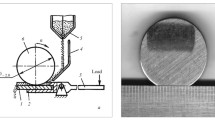The fracture intensity of high-nitrogen Mn steels under dry rolling friction with sliding for loads from 40 to 60 kg is determined. During friction, a decrease in the wear intensity with increase in the load is observed, which is related to the running-in of a material. The important factor that prevents the intensive wear of alloys is a passivation film, which is recovered under friction in the presence of oxygen. During setting, the sizes of wear products under a load of 50 kg are 30–50 μm. On the friction surface in the tear zones, a higher content of carbide-forming elements is observed. This testifies to the intense fracture of the material in the region of these elements.



Similar content being viewed by others
References
O. I. Balytskyi, V. O. Kolesnikov, and P. Kawiak, “Tribotechnical properties of austenitic manganese steels and cast-irons under sliding friction conditions,” Mater. Sci., 41, No. 5, 624–630 (2005).
V. V. Panasyuk (editor), Fracture Mechanics and Strength of Materials. Handbook, Vol. 8, O. I. Balyts’kyi, O. V. Makhnenko, O. O. Balyts’kyi, et al., Strength of Materials and Durability of Structural Elements of Nuclear Power Plants [in Ukrainian], Akademperiodyka, Kiev (2005).
J. Romu, J. Tervo, H. Hännien, and J. Liimatainen, “Wear resistance of high nitrogen austenitic stainless steels manufactured by molten and powder metallurgy routes,” in: V. G. Gavriljuk and V. M. Nadutov (editors), Proceedings of the 3rd Int. Conf. “High Nitrogen Steels HNS 93” [in Ukrainian], Institute for Metal Physics, Kyiv (1993), pp. 372–378.
V. I. Pokhmurs’kyi and Kh. B. Vasyliv, “Influence of hydrogen on friction and wear of metals (survey),” Fiz.-Khim. Mekh. Mater., 48, No. 2, 5–17 (2012).
A. Balitskii, J. Chmiel, P. Kawiak, et al., “Odpornośc na zużycie ścierne i niszczenie wodorowe austenitycznych stopów Fe–Mn–Cr,” Probl. Ekspl., 4 (67), 7–16 (2007).
A. Balitskii, V. Kolesnikov, and J. Chmiel, “The influence of microstructure and hydrogen – containing environments on the intensity of cast iron and steel damage by sliding friction. Part 1. Construction of a generalized model of surface layer friction of graphitized steel and cast-iron objects,” Probl. Ekspl., 4 (67), 17–29 (2007).
A. Balitskii, V. Kolesnikov, and J. Kubicki, “Ability to strengthening manganese doped iron—a reserve to increasing the exploitation stability of details for railway transport,” Industr. Tour. Transp., No. 3, 29–38 (2004).
M. I. Gol’dshtein, S. V. Grachev, and Yu. G. Veksler, Special Steels [in Russian], Metallurgiya, Moscow (1985).
Ya. D. Kogan, B. A. Kolachev, Yu. V. Levinskii, et al., Constants of Interaction of Metals with Gases. Handbook [in Russian], Metallurgiya, Moscow (1987).
M. A. Fillipov, “Metastable Mn austenite as a structural base of steels with high durability under dynamic contact loading,” Metalloved. Term. Obrab. Met., No. 10, 12–15 (1995).
T. F. Volynova, High-Manganese Steels and Alloys [in Russian], Metallurgiya, Moscow (1988).
L. Karlsson, “Stainless-steel – past, present, and future,” Svarka (Suvirinimas), No. 1 (4), 17–20 (2004).
G. P. Guslyakova, A. B. Kornev, and D. S. Guslyakov, “Friction coefficients and wear resistance of metal materials with various ability to the strain strengthening,” http://nic-rt.ru/magazine1.html .
“A stainless-steel strip,” Élektr. Resurs. OOO Mineralplity, http://minvata.megasklad.ru/page1205835961 .
G. Berg, C. Friedrich, E. Broszeit, and C. Berger, “Development of chromium nitride coatings substituting titanium nitride,” Surf. & Coat. Tech., 86–87, 184–191 (1996).
Author information
Authors and Affiliations
Corresponding author
Additional information
Translated from Fizyko-Khimichna Mekhanika Materialiv, Vol. 48, No. 5, pp. 78–82, September–October, 2012.
Rights and permissions
About this article
Cite this article
Balyts’kyi, O.I., Kolesnikov, V.O. & Eliasz, J. Study of the wear resistance of high-nitrogen steels under dry sliding friction. Mater Sci 48, 642–646 (2013). https://doi.org/10.1007/s11003-013-9549-7
Received:
Published:
Issue Date:
DOI: https://doi.org/10.1007/s11003-013-9549-7




